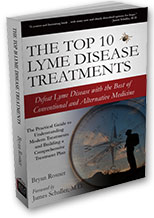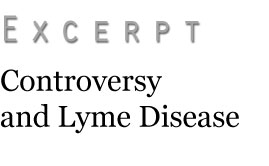|

Author Ken Singleton, M.D.
Excerpts from the Lyme Disease Solution:
Table
of Contents
Introduction
Chapter 1
Chapter 2
Chapter
3
Chapter 4
Chapter 5
Chapter 6
Chapter 7
Chapter 8
Chapter 9
Index
See our complete selection
of Lyme disease books and DVDs.
Customers who purchased The Lyme Disease Solution also
purchased the following book:

The Top 10 Lyme Disease
Treatments by Bryan Rosner
|
|
Paperback Book, 523 Pages, $29.95

The gravity of the health risks posed by this ongoing controversy is illustrated by the experience of the internationally renowned writer and novelist Amy Tan. On her Web site (www.amytan.net) and in her book, The Opposite of Fate, Tan recounts her multiyear struggle to make sense of her health symptoms, which began in 1999. Describing that struggle, she writes that her experience is “in many ways typical,” and that, as someone who primarily lives in California, she had little awareness of Lyme disease when she first began to notice her symptoms. Initially, because she had a history of being in good health, she passed off her early symptoms—“a stiff neck, insomnia, a constant headache, and a bad back followed by a frozen shoulder”—as being due to too much air travel. But then she began to experience tingling pains and numbness in her feet, which caused her to recall an odd rash she’d developed months earlier. Beginning as a tiny black dot that she mistakenly assumed was a small blood blister, it turned into “a growing red rash, which, curiously, did not itch, but lasted a month.” When she asked her physician if the rash might be related to her symptoms, she was told no.
As her symptoms continued to worsen, Tan was referred to a total of ten health care specialists and had “countless lab tests,” including an MRI that revealed lesions on her brain’s frontal, temporal, and parietal lobes that her doctors felt were normal for someone her age. Eventually, still without an accurate diagnosis, Tan reached the point where she was unable to leave her house alone, due to extreme fatigue, pain, and mental confusion that she feared were the early signs of Alzheimer’s disease. It was only after Tan began researching her symptoms on the Internet that she finally came to realize that she might have Lyme disease. Further online research led her to a physician who specialized in treating Lyme disease, who was able to confirm her diagnosis and begin an effective treatment plan. Today, she reports, she is making steady progress in her journey back to health, but adds, “I know that my late diagnosis means I am in this for years, perhaps even for life. But at least I have my mind back.” What makes Tan’s experience all the more illustrative of the challenges so many patients with Lyme disease face is the fact that all the doctors she consulted prior to finding her Lyme specialist “were affiliated with major urban hospitals, were tops in their department, well known, well respected.” Yet, these very competent medical professionals were unable to properly diagnose her problem, resulting in her condition worsening before she finally began to improve.
Tragically, Tan’s experience is all too common, due to the continued lack of understanding of Lyme disease by many in the medical community. But lack of understanding is hardly the only issue involved in the Lyme disease controversy. Far more serious is the ongoing “heated debate” that has arisen between researchers in the academic fields and clinical researchers and physicians who are actually in the trenches, as it were, doing their best to treat Lyme disease effectively. Most of the patients who come to these “doctors in the trenches” are the most difficult cases—those who have failed every other treatment protocol— and very often these cases require lengthy treatments in order to help patients recover their health.
Recently, the Lyme disease controversy became even more pronounced after fourteen members of the Infectious Diseases Society of America (IDSA) issued national guidelines. The unfortunate fact is that these guidelines have received general acceptance in the medical community. However, these guidelines may significantly diminish the ability of physicians who treat and diagnose Lyme disease to properly and effectively treat their patients. I would like to discuss examples of how these guidelines will impact Lyme patients.
Among the recommendations made by the IDSA are that physicians limit their treatment of Lyme disease to ten to twenty-eight days of oral antibiotics, with no more than a month of additional oral antibiotic use for patients with persistent symptoms and then only after a waiting period of time (giving Lyme a chance to further disseminate). The guidelines also recommend that physicians rely solely on two unreliable diagnostic criteria: the characteristic bull’s eye or erythema migrans (EM) rash and conventional screening blood tests for Lyme. I’ve already discussed how one half or more of people who develop Lyme disease never develop the EM rash. The conventional tests recommended by the IDSA for diagnosing Lyme are often of limited value because they only detect 50–60 percent of true Lyme cases. This means one third to one half of Lyme patients will be missed. (We will discuss this diagnostic dilemma in chapter 3.)
Most disturbing of all, the IDSA’s guidelines actually deny the existence of chronic or persistent Lyme infection, preferring to call it “Post-Lyme Disease Syndrome” (PLDS). PLDS is viewed as a chronic condition that some patients are left with after the Bb bacteria are killed off by the antibiotics. However, studies have shown that Lyme can persist after antibiotic treatment. Culture-confirmed failure of antibiotics was first reported in 1989. Several studies conducted in animals—mice, dogs, monkeys—indicate that Bb can persist after treatment is completed. Persistence of Lyme infection after treatment in humans has been confirmed by way of culture or molecular testing in at least twelve different studies.
If you would like
to learn more about the book before ordering it, feel free to browse
these excerpts, which are available online, free of charge:
Table
of Contents • Introduction
• Controversy
and Background
Symptoms
• Testing
and Diagnosis • Natural
Killer (NK) Cells
Anti-Inflammation
Diet • Medical
History and Physical Exam
Low
Dose Naltrexone (LDN) • Food,
Diet, and Omega Fatty Acids
Hope
and Positive Outlook • Index
"What I have accomplished with this 500+ page book, The Lyme Disease Solution, is to share my everyday knowledge and practical experience of 10 years as a Lyme-enlightened practitioner (who also is himself a Lyme-survivor). Although I hesitate to use the “cure” word in relation to chronic Lyme, the principles in this book have resulted in a greater than 90% response rate in my patients. At least 60% of my patients achieve long-term improvement that allows them to get off of antibiotics completely."
— Ken Singleton, M.D.
|
THE LYME DISEASE SOLUTION
By Ken Singleton, M.D.
Foreword by James A. Duke, Ph.D.
Paperback Book, 523 Pages, $29.95 + $7 Shipping & Handling |
|

|
Order By Phone: |
Order Online: |
| (530) 541-7200 |
 |
 |
BioMed
Publishing Group
P.O. Box
9012
South Lake
Tahoe, CA 96150
www.LymeBookStore.com
Contact Us
(801)
925-2411
|
Disclaimer:
The
products offered on this web site are intended for
informational and educational purposes only and are not
intended to prevent, diagnose, treat, or cure disease.
The statements on this web site have not been evaluated by
the United States Food and Drug Administration. If you have
a medical problem see a licensed physician.
Copyright
© 2007 BioMed | Advertise
with us
|
|
